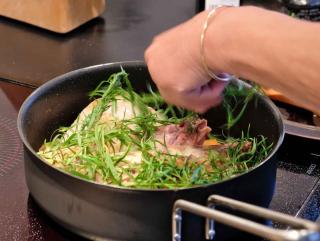

Tarragon or Artemisia dracunculus is an herb plant that belongs to the Compositae family, more accurately called the Asteraceae family.
This perennial with long, thin leaves is native to Central Asia (mainly Siberia) can reach 40 inches to 5 feet tall (40 to 150 cm).
The most grown group of tarragon plants is “French tarragon”. Russian tarragon grows faster and larger, but is tasteless.
Tarragon hosts true therapeutic benefits and very strong flavors.
In olden days, tarragon was mostly used for its medicinal properties, for example to treat snake bites or to soothe dental pain and interrupt hiccups. During Greek and Roman times, tarragon was involved in remedies to fend of the plague and cholera.
Tarragon reached Europe during the Middle Ages thanks to the Crusades.It only started being used for its culinary value in the XVIth century. The prince of Wales, George the Vth, is said to have been cured thanks to tarragon. Every morning, French queen Marie-Antoinette drank 5 tarragon leaves steeped in boiling water with lemon juice.
The Arabs considered tarragon to be a powerful aphrodisiac and would use it to prepare love potions.
Tarragon is excellent to stimulate your appetite and digestion, thanks to vitamin C.
It also appears very effective in case of bloating, aerophagia and stomach pain. It ensures proper transit. It is recommended in cases of light constipation. Tarragon is also a good diuretic. In case of intestinal parasites, tarragon acts as an excellent de-wormer. It purifies the body and filters out parasites.
For women experiencing amenorrhea or delay in menstruation, tarragon helps bring the menses back.
In case of muscle spasms, tarragon has very good antispasmodic properties since it acts on the nervous system. It can also soothe painful joints and cramps.
For sleeping disorders, tarragon deals with insomnia for you. It generally helps reduce feelings of oppression, internal tension and anxiety.
Tarragon can also decrease pain due to sore throat or dental pain. For that, simply chew on tarragon leaves.
Tarragon contains antioxidants that protect the body from free radicals, and hinder appearance of cardiovascular diseases, cancers and cell ageing.
External use of tarragon essential oil demonstrates anti-inflammatory and anti-allergy properties.
It is also an effective analgesic that, when applied during a massage, soothes menstrual pain, lumbago or even more painful experiences such as renal colic.
As regards skin care, tarragon essential oil can clear hives and dermatitis, simply by massaging it over the impacted areas.
Hiccups? Chew tarragon, this can help stop the hiccups.
Motion sickness or car sickness? A drop of tarragon essential oil under your tongue before setting out.
Preventive treatment against respiratory allergies, like hay fever: As the sun comes around, so does pollen, and allergies reappear. As a preventive routine to offset symptoms and reduce vulnerability to such situations, drip 3 drops of essential oil on a sugar cube (once in the morning, and once in the evening). Tarragon essential oil lowers the body’s histamine production, a molecule produced by the body that triggers symptoms related to allergy.
If ever you’re a diabetic person, though, avoid sugar by using a tissue: drip 3 drops essential oil on it and inhale.
Tarragon leaf infusion: let a few leaves steep in boiling water for 10 to 15 minutes. Drink all day long to purify the body and take advantage of all of tarragon’s benefits.
Digestive disorders: After each meal, ingest a teaspoon of honey with 2 drops tarragon essential oil.
Bathing with essential oil: In case of tension, stress or anxiety, pour about ten drops essential oil in your bath water. Another option is to rub some essential oil onto your solar plexus with your hand in a circular motion (on the chest, between your nipples), every evening.
However, high doses of tarragon are not recommended for pregnant or nursing women.
Tarragon skin might trigger a rash on sensitive skin. Verify if this is the case for you before applying it by trying out on a small portion of your skin. You can also simply dilute the tarragon into plant-based oil.

Whether it is fresh, chopped, powdered or still in branch form, it can flavor your soup dishes, mixed salads, omelettes, ratatouille, meat and fish meals.
However, don’t overdo it, because tarragon’s powerful flavor might overpower other nuances in the dish instead of contributing to making it better.
It’s important to reduce the amount of salt we ingest. Having too much salt as part of the diet increases arterial blood pressure and all related hazards: cardiovascular diseases, kidney deficiency…
Tarragon has high levels of iron, iodine, calcium, carotene and vitamin A, B and C. You can use tarragon to replace salt.
You can dunk a sprig of tarragon in your bottle of olive oil to give it an extra-special flavor.
Tarragon yogurt dip: Greek yogurt, olive oil and finely minced tarragon. Ideal for appetizers to use as a dip for cherry tomatoes, carrots, radishes, cucumbers…
Tuna rillettes: Mix a can of tuna with 3 table spoons sour cream, add one minced shallot and one table spoon each mustard and cottage cheese. Add 3 table spoons chopped tarragon. Add pepper to taste and spread on toasted full wheat bread.
Treat bad breath: chew tarragon leaves after your meal. But this shouldn’t keep you from brushing your teeth!
How to keep tarragon?